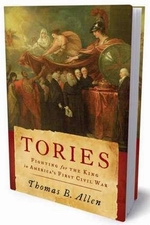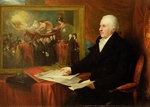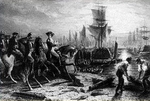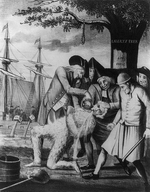|
Timeline
of a Revolution (and a Civil War)
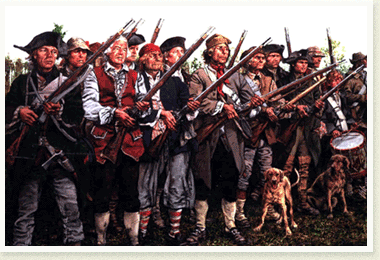
At Concord,
Massachusetts militiamen challenge British troops—and the
Tories marching with them.
National Park Service
1754
May: Lt. Col. George Washington of the Virginia Militia leads
Virginia militiamen into territory claimed by the French. His defeat
of a French patrol near today’s Uniontown, Pennsylvania, is a
prelude to the French and Indian War.
1756-1763
The French and Indian War—the North American portion of the
Seven Years War—pits Great Britain against France and Indians
allied with France; Spain joins France in 1762.
1763
February:
Under the treaty ending French and Indian War, Britain
gets the Spanish colony of Florida and part of the French colony of
Louisiana. The British form the territory into two colonies: East
Florida and West Florida.
October: King George III restricts the movement of colonists
by barring trade and settlement west of the Appalachian Mountains.
1764
April:
The British Parliament, without consulting the colonies, imposes its
first tax on them: a three-cent tax on
refined sugar. The Revenue Act also increases taxes on coffee,
indigo, and some wines; it also bans the importation of rum and
French wine.
May: A
Boston Town Meeting protests taxes that “are laid upon us in
any shape without ever having a legal representation where they are
laid….”
July:
A fort in Newport, Rhode Island, fires on the Royal Navy warship, HMS
St. John, in what is regarded as New England’s first
armed resistance to Britain.
1765
March:
Parliament, wishing to pay off Britain’s
massive national debt following the Seven Years War, passes the Stamp
Act, which requires colonists to buy a stamp that is affixed to every
piece of paper they use, including legal
documents, licenses, newspapers, and playing cards.
Parliament
passes the Quartering Act, which orders each colonial assembly to
provide British soldiers in America with bedding, cooking utensils,
firewood, beer or cider, and candles. A later amendment requires the
colonial assemblies to find billeting for the soldiers.
May: In his
first speech in the Virginia House of
Burgesses, Patrick Henry, attacking Britain’s treatment of the
colonies, says, “Caesar had his Brutus, Charles the First his
Cromwell, and George the Third — .” Cries of “Treason!”
interrupt him. He pauses before finishing the sentence: “...may
profit by their example. If this be treason, make the most of it.”
He later apologized and stated his loyalty to the king.
August:
A mob protesting the Stamp Act destroys the mansion of Thomas
Hutchinson, the lieutenant governor of Massachusetts Colony.
December: Boston
Sons of Liberty, once members of a secret organization, publicly call
for the resignation of the Massachusetts Distributor of Stamps.
1766
January:
The New York Assembly refuses to pay the full amount of money
requested by the Crown under to the Quartering Act.
March:
Parliament repeals the Stamp Act.
1767
November:
Parliament passes the Townshend Acts, urged by Chancellor of the
Exchequer Charles Townshend to raise revenue and tighten enforcement
of customs laws. Taxes are levied on imported glass, lead, paint,
paper, and tea. Another law aids customs officials by authorizing
blank search warrants called Writs of Assistance.
1768
February:
Massachusetts House of Representatives sends a Circular Letter,
written by Samuel Adams, to the legislature of the other colonies
declaring that the Townshend Acts were unconstitutional because of a
lack of representation in Parliament.
October:
British soldiers arrive in Boston to aid local colonial officials
curb Rebels.
1770
February:
A Loyalist, confronted by an angry mob, shoots and kills a
ten-year-old boy. Phillis Wheatley, already famed as a black
poet, writes a memorial poem and 2,000 march in a martyr’s
funeral staged by the Sons of Liberty.
March:
In a confrontation with a Boston mob, British soldiers kill five
people. Son of Liberty leader Paul Revere produces a sensational
color print and calls the incident “The Bloody Massacre.”
Reacting to the colonists’
boycott of British goods, Parliament amends revenue laws, removing
Townshend items except tea.
1772
June: Rhode
Island Patriots seize and torch the British warship Gaspee, which
had run aground while in pursuit of a suspected smuggler.
November:
John Adams proposes that the colonies establish a correspondence
network to keep everyone informed of political activities.
1773
March:
Virginia House of Burgesses creates a Committee of Correspondence
and Inquiry that will keep in touch with other colonies about
“affairs of this colony …
connected with those of Great Britain.”
Here, as in other colonies, Loyalists—Tories, as Patriots call
them—will not be on such committees.
May:
Parliament passes the Tea Act, which creates a monopoly. British
officials pick Tories in Boston as the exclusive merchants.
December:
Patriots in Boston dump tea from ships that Sons of Liberty had kept
from unloading.
1774
March: Britain closes the port of Boston; other colonies come
to the aid of Massachusetts.
July: Tories in Worcester, Massachusetts, denounce Committees
of Correspondence, charging that their “dark and pernicious”
actions were leading people toward “sedition, civil war, and
Rebellion.”
September:
The First
Continental Congress convenes
in Philadelphia in reaction to the closing of the port
of Boston and other “Intolerable Acts”: enlarging Quebec
and granting
religious freedom to Catholics living there; allowing royal governors
to appoint all law officers and have the power to move trials to
England; and a demand for expanded quartering of British troops. A
delegate with Tory leanings offers an attempt at conciliation, which
is rejected.
After
British troops seize powder from a magazine on Boston’s
outskirts, a mob surges into a Cambridge neighborhood called Tory
Row. The highest-ranking officer of the colony’s royal militia
flees for refuge in Boston, starting an exodus. Patriots begin
leaving Boston, now a British Army garrison.
October: In
the first direct action against Tories, the Congress creates a
committee for publicizing anyone who violates the non-importation
policies aimed at boycotting British imported goods.
December: New Hampshire Patriots capture a fort and seize its
arms.
1775
March: Prominent Tories, fearing the rise of rebellious
Patriots, ask Gen. Thomas Gates, now both royal governor and
commander in chief of British forces in North America, to send a
warship to Plymouth Harbor to provide an emergency exit for
Loyalists.
April: Firefights at Lexington and Concord pit Massachusetts
Patriots against British troops, aided by Tories. As news travels
down the eastern seaboard, thousands of militiamen head for
Cambridge, beginning the Continental Army.
May: Benedict
Arnold and Ethan Allen and the Green Mountain Boys capture Fort
Ticonderoga on Lake Champlain, acquiring cannon that will be taken to
Massachusetts.
The
Continental Congress, with delegates from every state but Georgia,
names George Washington of Virginia as commander in chief of the
Continental Army. He heads for Cambridge.
June: Patriots inflict heavy casualties on British troops in
what will be known as the battle of Bunker Hill.
Patriots in Machias, Maine, in a dispute involving a Tory trader,
seize a British warship.
July: The Loyal Americans
Association, first major Tory militant organization, musters in
Boston.
The Continental Congress adopts the
Olive Branch Petition, which asserts loyalty to the King. He refuses
to read the petition and will proclaim that the colonists had
“proceeded to open and avowed rebellion.”
August: In a confrontation
with Georgia Patriots, Thomas Brown, a Loyalist leader, is tortured
and will raise a vengeful Tory guerrilla band.
November: Lord
Dunmore, royal governor of Virginia, issues a proclamation
promising freedom to any slave who goes over to the British. Dunmore
organizes the Ethiopian Brigade of about 300 African Americans.
December:
Dunmore, whose Tory force includes his Ethiopian Brigade, leads a
battle against Rebel forces at Great Bridge, near Norfolk. Rebels
successfully hold the city, driving off British landing parties and
sending Dunmore off to in British-occupied New York City.
The
Patriots’ invasion of Canada, defended by both American and
Canadian Loyalists, ends in a failed attempt to capture Quebec.
1776
January:
Tom Paine’s Common Sense, a call for independence, is
published and becomes a best-seller.
February:
Patriots defeat a Tory force, led by Scot emigrants, at Moore’s
Creek, North Carolina, in a major setback for Carolinas Tories.
March:
The Continental Army, aided by
artillery captured at Ticonderoga, takes control of Dorchester
Heights in Boston and begins a siege of British troops.
Gen.
William Howe and his troops evacuate Boston and sail for Halifax,
taking with them about 1,000 Tory civilians. (See “The First
Exiles.”)
May:
Sir John Johnson, Britain’s Superintendent of Indian Affairs,
and his Tory supporters flee his New York domain, crossing into
Canada.
June: Sir John Johnson raises the First Kings Royal
Regiment of New York. Most recruits are Tories from the Mohawk and
Schoharie valleys.
July:
Congress declares independence, creating an absolute barrier between
Patriots and Tories. The first regiment of New Jersey Volunteers, a
major Tory military unit, is formed.
August:
British drive Washington’s Continental Army from Brooklyn.
September:
Nathan Hale, a Continental Army officer sent to spy on the
British, is captured on Long Island by Robert Rogers, who is
recruiting Tories for his Rangers. The British hang Hale.
October:
Benedict Arnold’s naval maneuvers on Lake Champlain stymie
pursuing British, and the Continental
Army’s retreat
from Canada ends. Tories aided the
British along the way.
British
capture New York City.
November:
A small Rebel force attempts a quixotic and unsuccessful invasion of
Nova Scotia, hoping to bring it into the Revolution.
December:
George Washington crosses the Delaware River and attacks 1,400
Hessians at Trenton, New Jersey, capturing most. He next takes
Princeton.
1777
March:
The Loyal American Regiment is raised by a leading New York Tory,
Beverley Robinson.
June:
Gen. John Burgoyne, with the Queen’s Loyal Rangers in the
advance corps, leaves Canada and begins his two-pronged invasion of
New York. His force includes Indians and Tories picked up along the
way.
August: A
Tory force of King’s Royal Regiment of New Yorkers and Indian
allies ambushes Patriots marching to relieve besieged Fort Stanwix in
the Mohawk Valley. About 160 Patriots are killed or wounded, as are
some 150 Tories.
Near Bennington, Vermont, a foraging
force of Burgoyne’s Hessians, Indians, and Tories clashes with
Patriot militiamen whom Hessian officers mistake for Tories. The
Patriots inflict so many casualties that the Mohawk Valley invaders
withdraw to Canada, robbing Burgoyne of vitally needed men.
September:
The British Indian Department in New York raises Butler’s
Rangers, a highly efficient raiding force made up of Tories and
Indian allies.
Washington
is defeated at Brandywine as British troops march on to take
Philadelphia. Tories line the streets to welcome them.
Congress
flees Philadelphia and reassembles in York, Pennsylvania.
October: Burgoyne surrenders to Gen. Horatio Gates at Saratoga, New
York; Tories in Burgoyne’s force flee to Canada, where they
will join military units.
The
victory convinces France to support the Patriots.
1st
Battalion of Maryland Loyalists is mustered.
December:
Washington’s army goes into winter quarters at Valley Forge.
While Continentals starve, Tory “market people” supply
British occupiers of Philadelphia.
1778
June: British troops and a rear-guard unit of Tories evacuate
Philadelphia, beginning a march to New York. Some 5,000 Tories also
leave for New York aboard Royal Navy ships.
Benedict Arnold, military commandant of Philadelphia, begins his
betrayal by bargaining with the British through a local Tory.
Washington’s army, well trained and better disciplined,
emerges from Valley Forge and pursues the British. At Monmouth, New
Jersey, the Continental Army mauls but does not defeat the British,
as they march to New York.
Virginia
Patriots, led by Lt. Col. George Rogers
Clark,
head west to take territory
long held by the British. Clark will capture several
British posts in the Ohio Territory (present-day Illinois and
Indiana).
December: The
British begin a southern campaign by taking Savannah, Georgia.
1779
July: A British force of about 2,600 soldiers—Regulars,
Hessians, and a major Tory unit, the King’s American
Regiment—makes a series of terror raids along the Connecticut
coast, torching and looting New Haven, Fairfield, and Norwalk.
October: A
joint American-French attempt to retake Savannah ends with the French
losing 635 men and the Patriots 457 while the British and Loyalist
defenders saved the city at a cost of 55 lives.
1780
May: British take Charlestown (Charleston), South Carolina;
more than 3,400 Continentals and Patriot militiamen surrender. Troops
under Gen. Charles Cornwallis, aided by Tory troops, head to the
interior on a campaign to conquer the South.
Gen.
Henry Clinton orders expansion of South Carolina Militia, under
British Army Major Patrick Ferguson. As many as 5,000 men will join
the militia and other Tory units in the state.
Lt.
Col. Banastre Tarleton, leading an all-Tory unit called the British
Legion, runs into a Patriot force at a place called the Waxhaws on
the North Carolina-South Carolina border. His men kill or wound more
than 300 Patriots as their commander seems to be surrendering.
Tarleton gets the reputation of a heartless killer called “Bloody
Tarleton.”
June:
Spanish force invades and occupies the British colony of West
Florida.
July:
Loyal Refugee Volunteers, a Tory guerrilla force, wards off an attack
on its New Jersey blockhouse by Continental Army General
Anthony Wayne.
August: British rout Gen. Horatio Gates and his army
at Camden, South Carolina.
Runaway slaves, recruited by the British, fortify Yorktown
and Gloucester.
September: Benedict Arnold, now in command of the crucial
Hudson River fort at West Point, meets with his British case officer,
Maj. John André, in a rendezvous set up by a prominent New
York Tory. The plot is exposed, Arnold escapes, but André is
captured.
British
Army Major Patrick Ferguson, who recruits Tories of the Carolinas for
his all-Tory American Volunteers, warns “OverMountain Men”
that if they do not join him he will march his Tories over the
mountains and torch their homes.
October:
The
Overmountain Men round up about 1,400 militiamen, track down Ferguson
at King’s Mountain on the Carolinas’ border, kill him and
kill, wound, or capture his 1,100 Loyalists. In the
battle—turning point of the war in the South—everyone but
Ferguson is an American.
Maj.
André is hanged.
1781
January:
Newly commissioned a British
general, Benedict Arnold leads his American Legion—1,600 Tories
and Continental Army deserters he had recruited—on an
amphibious invasion of Virginia. The invaders raid Richmond and
occupy Portsmouth after
destroying tobacco warehouses.
At Cowpens, South Carolina, Gen. Daniel Morgan leads his
Patriots in a classic military tactic known as a double envelopment.
They soundly defeat British forces commanded by the hated—and
targeted—Tarleton, who gets away.
March: Washington sends about 3,000 men under Marquis
de Lafayette to Virginia. He prevents the British
from taking Richmond.
|
At
Guilford Courthouse, North Carolina, Gen. Nathanael
Greene is defeated by Gen.
Cornwallis but inflicts heavy casualties, continuing his strategy
to wear down the British.
|
|
April: A
fleet of 20 vessels carries 7,000 Loyalists from New York City to
promised land in Canada.
June: Gen.
Greene begins a 28-day siege of a fort at Ninety Six, South
Carolina, a Loyalist stronghold held by about 550 Tory troops. As
a British relief column nears, Greene withdraws.
July:
British troops evacuate Savannah. Hundreds of Tories go with them.
Georgia, the only colony to be conquered by the British,
had reestablished royal militias, which the Patriots must disband.
|
September: A
joint French and American army under Washington maneuvers to encircle
and besiege Cornwallis, who holds Yorktown, Virginia, in anticipation
of support from the Royal Navy via the York River.
A French fleet in Chesapeake Bay defeats a British fleet, preventing
a Royal Navy rescue of Cornwallis.
Benedict Arnold leads a combined force of his
Tory American Legion, other Tory units, and British troops on a raid
on New London, and Groton Heights, Connecticut. They torch New London
and massacre the defenders at Fort
Griswold.
October: Cornwallis surrenders, ending the last major military
engagement of the war.
Tories among Cornwallis’ troops slip away, many reaching
British-occupied New York.
December:
British troops, accompanied by hundreds of Tories, evacuates
Charlestown (Charleston).
1782
March:
Pennsylvania militiamen massacre Delaware Indians—62 adults and
34 children—at the Moravian
missionary village of Gnadenhutten, Ohio, in the belief the Christian
Indians were Tories.
A
mixed force of William Franklin’s Associators and Pennsylvania
Tories attacks a blockhouse at Toms River, New Jersey, and torches
the town. They later hang a Patriot defender, triggering events that
lead to Washington’s contemplating a retaliatory hanging of a
British officer. Ultimately Count de Vergennes, the French
foreign minister, intervenes lest the incident affect the war-ending
treaty negotiations in Paris.
1783
February:
Britain announces an end to hostilities.
September:
The Treaty of Paris is signed by delegates from America, Britain,
Spain, France, and the Netherlands.
November:
the last British soldiers are evacuated from New York City, along
with about 30,000 Tories, who join the Loyalists already in Canada.
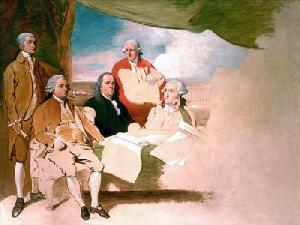
In
Benjamin
West’s
painting of the delegations at the Treaty of Paris, only Americans
are visible: John
Jay,
John
Adams,
Benjamin
Franklin,
Henry
Laurens,
and William
Temple Franklin,
Benjamin Franklin’s grandson, secretary of the delegation.
Because the British delegation refused to pose, the painting was not
finished.
----
On
January 14, 1784, the Treaty of Paris was ratified by Congress,
officially ending the
Revolutionary War. By then upwards of
100,000 Tories had left the country.
| 